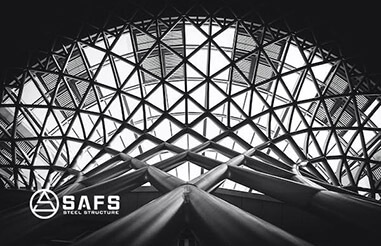Dapeng Town Industrial Park, Tongshan District, Xuzhou City, Jiangsu Province, China
Space truss structures have certain requirements for production and construction technology and processing equipment, mainly because they use intersected welded nodes, so space truss structures are limited in their application. What are the important types of space truss structures?
Space truss structures can be divided into rectangular tube trusses and circular tube trusses according to the cross-section shape of the components. As structural components, square steel tubes have the advantages of easy vertical cutting at the joints and good bending performance, and have been widely used in developed countries.
Butt welded joint square steel tubes do not require bracing plates or node plates, which reduces the steel consumption at the joints and makes the joints simpler. The components are more convenient to connect, and the architectural expression is better. In addition to having a very high moment of inertia and efficient anti-twisting cross-section, the circular steel tube truss has the advantage that its surface has no uneven angles, which is beneficial to aerodynamics in appearance.
The manufacture of circular steel tube structures is more expensive than that of rectangular tube structures. If the chord member is comparatively smaller than the support member, and if it’s welded directly to it without requiring additional parts like bracing or node plates; this reduces material usage at connections while simplifying them. Rectangular tubes provide excellent connection surfaces for supporting other elements placed on top chords within a structure compared to round tubes due to their flat sides.
When selecting materials for transportation purposes as well as storage convenience; rectangular steel tubes outperform round ones.”
Revised sentence: “Different Types of Space Truss Structures.
Space truss systems impose specific demands on manufacturing processes, construction techniques, and fabrication tools due primarily to their utilization of intersecting welded nodes—thus limiting their applicability. What distinguishes these essential types?

Classified by component cross-sectional shapes into rectangular tube assemblies or circular counterparts; square steel tubing offers favorable attributes such as ease-of-cutting at junctions along with superior bending characteristics—resulting in widespread adoption across advanced economies.
Butt-welded square tubing obviates any need for supplementary bracing or node plates—thereby reducing material consumption while streamlining connections with enhanced architectural aesthetics. Furthermore, circular tubular configurations boast smooth surfaces devoid of irregular angles—aerodynamically advantageous alongside exceptional resistance against torsion owing to significantly high moments of inertia.
However, fabricating circular tubular frameworks proves costlier relative to their rectangular counterparts—an expense further compounded when dealing with intersection cuts during assembly necessitating specialized equipment unlike straightforward vertical cuts associated with rectilinear profiles.
Rectangular tubing also excels in facilitating transportation logistics coupled with storage efficiency—a notable advantage over cylindrical alternatives.”